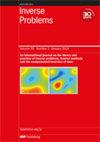用于障碍物探测的纳维-斯托克斯方程分布式参数识别
IF 2
2区 数学
Q1 MATHEMATICS, APPLIED
引用次数: 0
摘要
我们提出了一个标量渗透场的参数识别问题,以及根据参考剖面确定流入流中最大速度的问题。我们利用纳维-斯托克斯方程的修正版,在动量方程中加入布林克曼定律描述的渗透项。这一修改考虑到了边界某些部分存在障碍物的情况。对于流出的气流,我们采用了定向无为条件,作为稳定回流的一种手段。这项工作扩展了我们之前发表在《逆问题 37 025010》(Aguayo et al 2021 Inverse Problems37)上的研究,在该论文中,我们考虑了一个线性奥森模型的类似逆问题,该模型在出口处设置了无边界条件,并进行了二维数值模拟。在此,我们考虑了更现实的纳维-斯托克斯方程,并对流出流进行了回流修正,还对更现实的三尖瓣心脏瓣膜进行了三维模拟识别。参考速度可能会有一些噪声或以低分辨率获得,我们根据参考速度定义了一个合适的二次成本函数,其中包含一些正则项。通过纳维-斯托克斯方程解与渗透率和流入口最大速度的可微分性,推导出最小值的存在以及一阶和二阶最优条件。最后,我们介绍了一些基于二维和三维核磁共振成像的总速度和局部速度测量恢复心脏瓣膜的二维和三维形状的合成数值测试。本文章由计算机程序翻译,如有差异,请以英文原文为准。
Distributed parameter identification for the Navier–Stokes equations for obstacle detection
We present a parameter identification problem for a scalar permeability field and the maximum velocity in an inflow, following a reference profile. We utilize a modified version of the Navier–Stokes equations, incorporating a permeability term described by the Brinkman’s Law into the momentum equation. This modification takes into account the presence of obstacles on some parts of the boundary. For the outflow, we implement a directional do-nothing condition as a means of stabilizing the backflow. This work extends our previous research published in (Aguayo et al 2021 Inverse Problems
37 025010), where we considered a similar inverse problem for a linear Oseen model with do-nothing boundary conditions on the outlet and numerical simulations in 2D. Here we consider the more realistic case of Navier–Stokes equations with a backflow correction on the outflow and 3D simulations of the identification of a more realistic tricuspid cardiac valve. From a reference velocity that could have some noise or be obtained in low resolution, we define a suitable quadratic cost functional with some regularization terms. Existence of minimizers and first and second order optimality conditions are derived through the differentiability of the solutions of the Navier–Stokes equations with respect to the permeability and maximum velocity in the inflow. Finally, we present some synthetic numerical test based of recovering a 2D and 3D shape of a cardiac valve from total and local velocity measurements, inspired from 2D and 3D MRI.
求助全文
通过发布文献求助,成功后即可免费获取论文全文。
去求助
来源期刊

Inverse Problems
数学-物理:数学物理
CiteScore
4.40
自引率
14.30%
发文量
115
审稿时长
2.3 months
期刊介绍:
An interdisciplinary journal combining mathematical and experimental papers on inverse problems with theoretical, numerical and practical approaches to their solution.
As well as applied mathematicians, physical scientists and engineers, the readership includes those working in geophysics, radar, optics, biology, acoustics, communication theory, signal processing and imaging, among others.
The emphasis is on publishing original contributions to methods of solving mathematical, physical and applied problems. To be publishable in this journal, papers must meet the highest standards of scientific quality, contain significant and original new science and should present substantial advancement in the field. Due to the broad scope of the journal, we require that authors provide sufficient introductory material to appeal to the wide readership and that articles which are not explicitly applied include a discussion of possible applications.
 求助内容:
求助内容: 应助结果提醒方式:
应助结果提醒方式:


